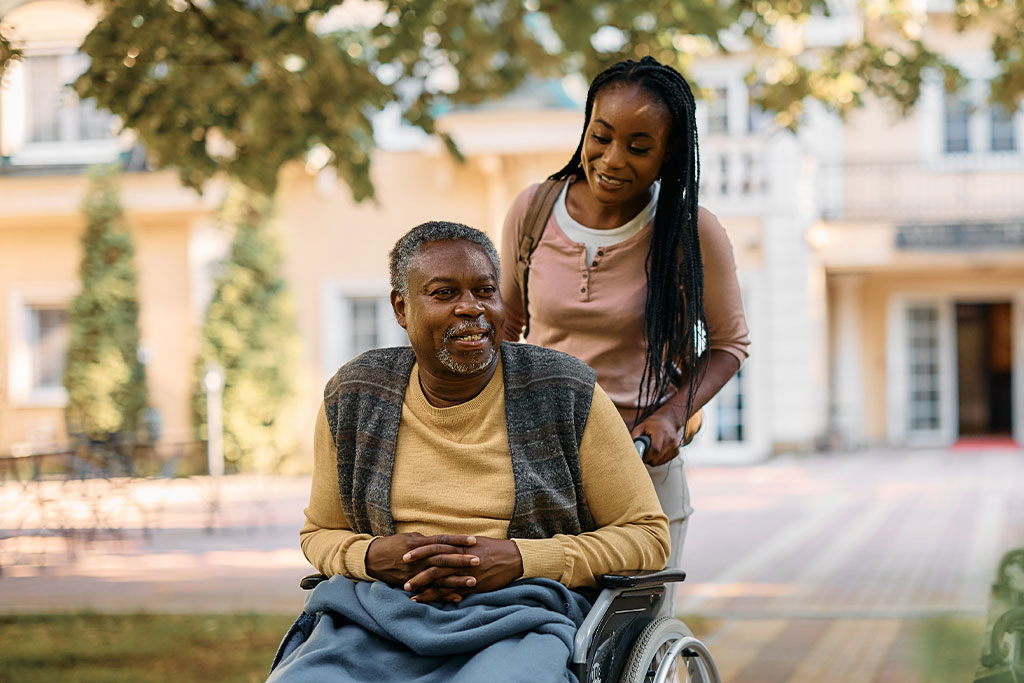KEY TAKEAWAYS
- Aging-in-Place offers the benefit of living at home but also presents challenges to mental health.
- Social connections, physical activity, mental stimulation, and emotional support are just a few ways to combat feelings of isolation.
- Aging requires a holistic approach to mental health and putting these practices in place can enhance the quality of life.
Aging-in-place offers numerous benefits, allowing seniors to maintain their independence, familiar surroundings, and cherished memories. However, in this post-pandemic era where so much of life happens within the home, it’s important to address the unique challenges that may arise, such as feelings of isolation. If you’re supporting a family member or friend who is aging-in-place, here are some suggestions on how you can offer support.
Foster social connections.
Prolonged social isolation can significantly impact a person’s mental and physical health—and this is true for us all, not only seniors. Recent findings point to the fact that loneliness can shorten our lifespan so nurturing relationships with others is key to longevity and happiness. Possible outlets for social connection can include:
- Active participation in local community centers, senior clubs, church, or hobby-based groups.
- Facilitation to technology and guidance on how to use social media or video calling platforms to connect with friends and family.
- Regular in-person gatherings with neighbors, friends, or family members who live in the area.
- Volunteering opportunities that offer the twofold benefit of social connections and engaging in a purposeful activity that brings benefit to the community.
Our HUD-certified counselors can begin a conversation about where you are today. Take the first step and call.
Promote physical well-being.
The more we move, the better we feel—stagnation isn’t just a mental state but also a physical one. Even small amounts of exercise (like daily neighborhood walk) boosts metabolism, improves cardiovascular health and stabilizes mood. Beyond walking, additional activities might include:
- Yoga or Tai Chi at a community center or at home (there are free streaming fitness apps that offer virtual, instructor-led sessions).
- Group or individual water fitness classes which provide a full body workout and enhance joint flexibility.
- Gardening, backyard projects, or—in colder seasons—DIY home projects that keep you moving throughout the day.
- Dancing instruction at a local studio—many facilities will offer discounted rates for senior students.
Encourage mental stimulation.
Nurturing our cognitive function is important, especially as we age. Mental health has a significant impact on our physical well-being, and this is especially true for seniors who may have previously enjoyed a mentally stimulating role at work and struggle with feeling challenged post-retirement. Here are ways to stay mentally sharp throughout the day:
- Reading books, solving crossword puzzles, or engaging in brain-training exercises (there are an abundance of apps across these categories).
- Investing in a new skill, such as painting or playing a musical instrument. As with fitness courses, many community centers offer senior discounts.
- Encouraging participation in local town halls, public author readings, and online workshops.
- Hosting or joining a home-based book, gardening, or crafting club.
Provide emotional support.
Seniors aging-in-place often must navigate the emotional challenges that accompany aging, retirement, empty nest syndrome if they have children, and the grief of losing loved ones. Consider the fact that most people don’t wish to feel like a burden and may benefit from proactive support. Here are some ways to show up:
- Encouraging transparent communication about their feelings and emotions—being a compassionate listener and sounding board.
- Assistance in finding professional counselors or therapists, ideally those with an emphasis in geriatric counseling.
- Encouragement to join senior support groups either online or in-person—these groups are often found through community clinics, churches or on community websites.
- Introducing journaling, letter writing, or meditation exercises.
- Cultivating a comforting home atmosphere with thoughtful décor, framed photographs, and organized spaces.
Our HUD-certified counselors can begin a conversation about where you are today. Take the first step and call.
Ensure safety and accessibility.
Physical and mental health are only sustainable in an environment that doesn’t pose hazards to health or safety. Taking inventory of what’s needed and setting up proper precautions is vital for seniors’ overall well-being. Some steps you’ll want to take might include:
- Conducting home safety assessments and making necessary modifications, such as installing grab bars in the bathroom or removing tripping hazards.
- Ensuring their home is well-lit and equipped with smoke detectors and carbon monoxide alarms.
- Encouraging the use of medical alert systems or wearable technology for emergencies. (Smartphones typically have a one-press emergency call option as well.)
- Organizing regular check-ins with neighbors or friends to ensure their well-being and having phone numbers easily accessible.
Invest in financial health.
Finances are a source of stress for many Americans, and seniors are particularly vulnerable with the increase of unforeseen medical expenses. Here are some best practices when it comes to staying on top of financial health:
- Money, and debt in particular, is too often shrouded in feelings of shame— create an honest, open space for dialogue around money management.
- Set up alarms and calendar reminders for current monthly bill payments.
- Invest in online security measures to keep passwords and vital information protected—seniors are a prime target for sophisticated phishing scams and identity theft.
- Connect with 995Hope for free housing counseling and guidance from HUD-certified counselors to get back on track with rent, mortgage payments and reverse mortgage issues.
Supporting the mental health of seniors who are aging-in-place requires a holistic approach that transcends any single category—there must be awareness around the complex intersections of mental health, physical health, and safety. By implementing some of these practices, we can create an environment for our loved ones that promotes fulfillment and a higher quality of life.




